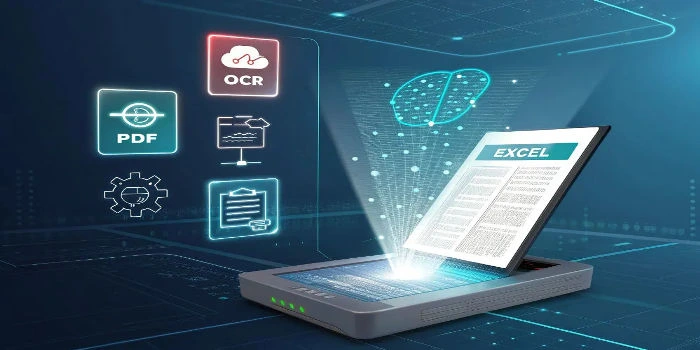20-22 Wenlock Road, LONDON, N1 7GU
20-22 Wenlock Road, LONDON, N1 7GU

In today’s fast-paced digital world, data extraction from documents plays a vital role in improving productivity and ensuring the seamless flow of information. Scanned PDFs, especially those containing tables, financial data, or business reports, are often challenging to extract and manipulate. This is where Optical Character Recognition (OCR) technology comes in, allowing you to transform scanned PDFs into editable formats like Excel, which is crucial for businesses, analysts, and anyone dealing with data regularly.
If you’ve ever found yourself struggling to extract information from a scanned PDF to Excel, this guide is for you. We’ll walk you through the process of converting scanned PDFs into Excel using OCR tools, discussing the best methods and offering tips for optimal results.
Before we dive into the methods, it’s important to understand what OCR technology is. OCR is a technology that converts different types of documents — such as scanned paper documents, PDFs, or images captured by a digital camera — into editable and searchable data. This conversion process involves identifying text, numbers, and characters in an image or scanned document, then converting them into machine-readable formats like Excel, Word, or plain text.
OCR has become an essential tool for businesses, especially for automating workflows, reducing manual data entry, and extracting valuable data from printed documents.
The conversion of scanned PDFs to Excel can save a significant amount of time, especially when you need to work with large volumes of data. Here are some reasons why OCR technology is a game-changer:
The first step in converting scanned PDFs to Excel is choosing the right OCR software or tool. There are several OCR tools available, both free and paid, that can help you extract data from scanned documents. If you are looking for a tool to scan financial documents, then Caelum AI can be a good pick for you. Its AI-powered technology helps you process financial documents with 99% accuracy.
Once you’ve selected an OCR tool, the next step is to upload your scanned PDF file to the platform. Most OCR tools have a simple drag-and-drop interface that makes uploading documents quick and easy. Ensure that your PDF is scanned clearly, with legible text, as OCR accuracy depends on the quality of the document.
After uploading the scanned PDF, you will need to select the output format. For this guide, we’re focusing on converting the PDF to Excel. Most OCR tools provide a variety of export options, including Excel (.xlsx or .xls), Word, and plain text formats.
Now, initiate the OCR process. The tool will analyze the scanned PDF, recognize the text, and convert it into a machine-readable format. Depending on the OCR tool and the complexity of the PDF, this process may take anywhere from a few seconds to several minutes.
Once the OCR process is complete, you can download your Excel file. Open it to review the converted data. While OCR technology has advanced significantly, it’s always a good idea to double-check the extracted information for accuracy. Verify that the tables, numbers, and text have been correctly converted.
Sometimes, OCR may struggle with complex layouts or heavily formatted PDFs, so minor adjustments may be needed to ensure that the Excel sheet is properly structured.
After reviewing the file, you can start editing the Excel sheet as required. You can add new data, perform calculations, create graphs, or manipulate the information however you see fit. Excel’s powerful tools make it easy to organize and analyze data extracted from scanned PDFs.
While OCR technology is highly efficient, there are some tips you can follow to ensure the best results:
Converting scanned PDFs to Excel using OCR is a powerful way to save time, reduce manual data entry, and improve data accuracy. With the right OCR tool and a little attention to detail, you can effortlessly transform scanned documents into editable Excel files, making it easier to analyze and manipulate the data. Whether you are dealing with invoices, financial reports, or any other type of data-heavy document, OCR technology is an invaluable asset.
By following the steps outlined in this guide and adhering to best practices, you can streamline your document processing and make your workflow more efficient.
OCR technology has improved significantly, but it still struggles with handwritten text. If the handwriting is legible and neat, it may work well, but for more complex handwriting, the results might not be as accurate.
Yes, there are several free OCR tools available online, such as Online OCR, i2OCR, and OCR Space, that can help you convert scanned PDFs into Excel files. However, they may have limitations on file size or features.
To improve accuracy, ensure your PDF is high resolution (at least 300 DPI), and the text is clear without any distortion. Use a clean layout with minimal graphics or backgrounds. Additionally, check the OCR settings for language and font recognition.
Yes, Adobe Acrobat is not the only OCR tool available. There are many other OCR programs, such as ABBYY FineReader, or free online tools, that can convert scanned PDFs to Excel without requiring Adobe Acrobat.
The time it takes to convert a scanned PDF to Excel depends on factors like the OCR tool used, the complexity of the PDF, and the size of the document. Typically, it can take anywhere from a few seconds to a few minutes.